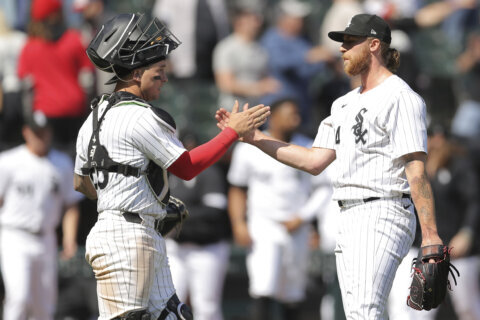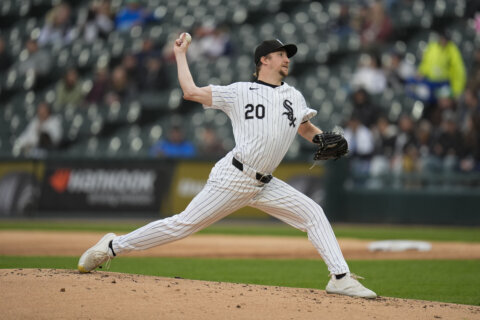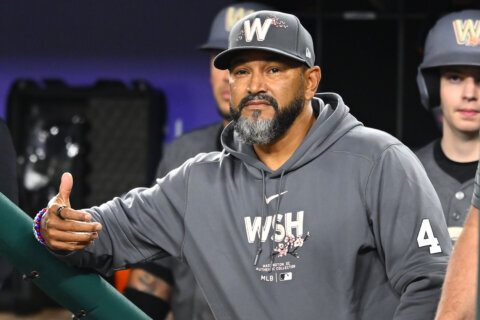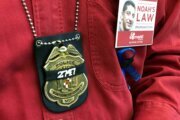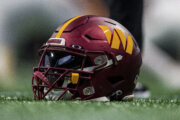Nats’ player development director gives updates on top prospects originally appeared on NBC Sports Washington
Among the many complications presented by Major League Baseball’s ongoing lockout has been a lack of information made available about players’ health, progress and goals for 2022. Managers and GMs typically meet with the media at least a few times throughout the offseason, providing updates on their roster with press conferences and interviews.
However, clubs have been barred from publicly discussing any players on 40-man rosters during this work stoppage. MLB went as far as removing any references to them from their website, a stunt that made trolls out of several high-profile players. So fans have been forced to sit through this offseason with very few updates on the players they hope to see back on the field this year.
So when Nationals Director of Player Development De Jon Watson sat down with reporters for a press conference Saturday, he answered a wide-ranging series of questions about the team’s top prospects and its plans for utilizing a revamped staff to turn them into major leaguers. Though he was still not permitted to speak about players such as Stephen Strasburg and Juan Soto, Watson did touch on many of the minor leaguers that already reported to West Palm Beach for early camp.
Here are some of the biggest topics Watson discussed, presented in the order they were mentioned.
Goals for early minor league camp
“The goal was to get some of these young kids a head start on spring training. There were some delivery things we wanted to address with some of the [pitchers], some swing stuff we also wanted to do with some young hitters. We have a ton of new instructors here so it’s an opportunity for them to get to know these kids in a slightly more relaxed environment before everyone starts competing for roster spots.
“This is a chance…to work on our leadership building, really set the tone for what kind of camp we want to have, what brand of play we’re going to bring to the table this year and what it’s going to look like here when we get the full population of players.”
The Nationals’ minor-league camp officially opens Thursday for pitchers and catchers with position players required to report a week later. Last week, they kicked off baseball activities by inviting a group of younger players mixed with some non-roster invitees to participate in drills and start ramping up for the season.
They have 67 total players in early camp, including 36 pitchers, six catchers, 17 infielders and eight outfielders. All four of the Nationals’ first-round picks since 2018 — Brady House, Cade Cavalli, Jackson Rutledge and Mason Denaburg — are in attendance as well as highly regarded international signees Armando Cruz, Andry Lara and Roismar Quintana. Several veteran players signed to minor-league deals such as Dee Strange-Gordon and Jefry Rodriguez made it out as well.
Jackson Rutledge
“He’s been working on his delivery, which is a lot better from the Fall League to where we are right now. It’s really about pitch usage, understanding how his mix is gonna play and how to attack the hitters that he’s facing. So those are some of the areas that we’re gonna really focus on coming out of camp and really, we have to hone in on the role.
“What does he fit? Is he a starter? Is he a reliever? Really understanding the dynamic of the skills and how they play for us and how are they going to play for us in the future. Right now, he’s in the starting rotation, we’re gonna keep him in the rotation but…we’re trying to get the best arms up the minor-league system as quick as we can to provide insurance for our big-league club.”
This is the first time the Nationals have acknowledged that 2019 first-round pick Jackson Rutledge could end up in the bullpen. Rutledge, 22, endured an injury-riddled 2021 campaign that saw him post a 7.68 ERA in 13 starts across three levels of the minor leagues. He spent the latter half of the season adjusting his delivery to put less pressure on his shoulder and his Arizona Fall League results (6.98 ERA in 19 1/3 innings) indicate he still has some work to do.
Yet, Rutledge still has the chance to develop into the starting pitcher the Nationals hoped he could be when they drafted him 17th overall. His fastball is among the best in their farm system and his slider is a true out pitch as well. If he can further develop his curveball and changeup, Rutledge has a case to stick in the rotation. But should he be unable to expand his repertoire, the Nationals may be forced to make him a reliever in order to best utilize his fastball/slider combination.
Cade Cavalli
“He’s still evolving and growing as a pitcher. You’re talking about a two-way player, out of college, who’s just really been starting for a couple of years now. So there’s some lessons to be learned: understanding how to be successful with his mix — he’s gonna have days where he feels great physically, you’re gonna have days when he’s not feeling as well but still have to compete and keep the club in the game and stay competitive — understanding how to pitch if he’s given up a lead early [and] how you sustain that.
“So all those lessons that I think he still has to learn and he will learn over time. Those are some of the areas for me that I think he still needs to close down and we’ll work on that here in camp and as we get out of camp so it’ll be fun.”
Cade Cavalli broke out in a big way last season, leading all minor-league pitchers with 175 strikeouts to go with a 3.36 ERA across 24 starts. He finished the year at Triple-A Rochester, where his command issues caught up to him a bit. Those last few starts haven’t stopped the hype train, however, as Cavalli enters the 2022 season as one of the Nationals’ few consensus top-100 prospects.
This year, the Nationals will look for Cavalli to show he can build off his career-high 123 1/3 innings count and understand what it takes to be a professional starting pitcher — both on the mound and between starts. The right-hander is expected to begin the season back in Rochester. A strong start to the year should have him knocking on the door of the major leagues.
Drew Millas
“Drew was a great acquisition for us. I love the switch-hitting catcher with a great strike zone awareness. This guy manages the zone exceptionally well enough if you’ve done any homework on him…I think you’d be really impressed. For a catcher who’s also a field leader, you almost need some type of personality because you have to really get out and communicate with a lot of different pitchers on your staff.
“You need to have that extroverted personality to a certain degree because you really have to understand how they’re wired, how they compete when they’re going well, when they’re not going so well how do you get them back into a game plan if they get out of it. So he’s been fun, he’s been a great kid to work with and talk with. His approach is improving and my big thing for him is handling that staff and [showing he can] lead that staff when he’s on the field.”
One of the more under-the-radar players the Nationals acquired in their trade deadline fire sale last summer, catcher Drew Millas came over from the Oakland A’s with a reputation for elite defense and impressive plate discipline. He brought those traits with him to Washington, doing well in High-A Wilmington before representing them in the Arizona Fall League.
Millas hit .196 in Arizona but drew 13 walks in 17 games to post a strong .359 on-base percentage. His patience at the plate has continued to impress the Nationals; Baseball America graded his eye for the strike zone as the best in their farm system. Although catcher has become a deep position in the Nationals’ organization with the acquisitions of Keibert Ruiz and Riley Adams, Millas isn’t getting overlooked so far.
Armando Cruz & Andry Lara
“The message really is to pay attention to the guys around you that are in that room, see how they’re going about their business. Armando has tremendous energy and extreme upside so I’m really looking forward to seeing him mature and grow and I think it gives him a chance to really gauge with the other players…and he can actually see for himself how do his hands match up, how is his quickness matching up, watching those guys in batting practice how do they go about their approach, the way they carry themselves once they get to the ballpark and how are they carrying themselves off the field.
“There are a lot of lessons to be learned for a young player like him as well as Lara. I think Lara, for him going out to A-ball at the end of the season last year was a big jump for him. I think he learned a lot about how he needs to refine his mix to be successful at the next level so it’s all growing the young men, getting them prepared for what’s in front of them.”
The Nationals’ top international signee in 2020, Armando Cruz spent all of last season at the club’s youth academy in the Dominican Republic. He appeared in 48 games for their Summer League team, hitting .232 with one home run and 11 stolen bases en route to a .597 OPS. It wasn’t a stellar showing, but the 18-year-old is still early in his development and his defense at shortstop is his calling card.
Lara, a right-handed pitcher, is only a year older than Cruz. He made his first professional appearance in the U.S. last year, spending time with their Florida Complex League team before moving up to Low-A Fredericksburg for two starts to close out the season. Lara was the highest-paid member of the Nationals’ 2019 international class and his upside should come into focus this year.
Cristhian Vaquero
“Big, strong, athletic, switch hitter, center fielder, tooled up. Really looking forward to getting him in the fold so we can start moving forward with him. I haven’t had a chance to work with him yet but I’ve definitely seen him at the complex when I went down [to the Dominican Republic] when I went down on my last trip. So we’re really looking forward to getting that completed and getting him moving.
“But he’s gonna be a fun, exciting player. From the videos that I’ve seen, really electric hands from both sides of the plate with emerging power and I think the defensive skillset…right now I’d say it’s above average currently. I think it’s gonna be well above average as we get moving.”
Watson said he “would imagine” that Vaquero spends the entire season in the Dominican Republic, similar to what Cruz did in 2021. The five-tool prospect tied for the largest signing bonus in Nationals history this winter, inking a deal for $3.9 million. He’s already one of the highest upside players in their farm system despite only being 17 years old.
It’s going to be a while before Vaquero reaches the major leagues, but his development is one the Nationals will pay close attention to moving forward. Nationals’ Assistant GM Johnny DiPuglia compared him to an Alabama wide receiver, and he just recently took up switch-hitting to add to his already-impressive profile.
40-man minor leaguers not in camp due to lockout
“Once we’re able to meet, we’ll address it once they get here. We have to understand where they are as far as what they’ve done thus far doing the offseason. I’m sure all of these kids are doing what they need to do to get themselves prepared for spring training. Most of them have been in an organization for a period of time so they know how to get their bodies prepared for this. So we’ll just have to see where they are when they get here and we will adjust accordingly.”
The Nationals’ 40-man roster currently includes five players that have never reached the majors: Yasel Antuna, Gerardo Carrillo, Donovan Casey, Lucius Fox and Evan Lee. Two others — Joan Adon and Jhon Romero — have nothing more than a September cup of coffee to their names. These players would be in major-league camp during a normal offseason but are instead forced to sit out with the MLB contingent of players despite their peers getting started.
Just as fans have gone most of the offseason without updates on their favorite players, the Nationals haven’t been allowed to correspond with these minor leaguers. The Athletic reported that there is some wiggle room for training staffs to communicate with personal trainers, but this would be the extent of any communication these prospects have had with their organization since Dec. 2.
Brady House
“He looks good in camp here early. I think the biggest thing is really understanding how to play the position of shortstop. We’re working on that extensively here. He’s getting lots of early work, there’s some things we just need to clean up on the defensive side of the baseball. I think his offensive skills will take care of itself, really understanding how to manage his game and how pitchers are trying to attack him. So we’ll just play that by ear. If we were leaving tomorrow, I would say he has a really good chance of making an A-ball roster coming out of camp.”
“We’re gonna do everything we can to see if this is the natural position for him…I had another really tall shortstop I had over in that other place on the West Coast and he’s still playing and got a whole lot of money just recently so I’m saying let’s give this thing a little time.”
The question for Brady House since the day he was drafted No. 11 overall is whether he’ll stick at shortstop long term or move over to third base. His bat, and in particular his power, has left little doubt of his potential. He made his professional debut in rookie ball last year and proceeded to post a .322/.394/.576 slash line with four doubles in 16 games.
House will likely begin the 2022 season in Low-A Fredericksburg, where he’ll look to show that a 6-foot-4, 215-pound player can play shortstop and do it well. The other “really tall shortstop” Watson referred to is Corey Seager, who signed a 10-year, $325 million deal with the Texas Rangers this offseason after seven years with the Los Angeles Dodgers. Seager is also 6-foot-4, 215. House faces an uphill battle trying to stay at short, but the Nationals are going to give him every opportunity to try.
Cole Henry
“He’s looked good in his two bullpens. He’s coming back from the Fall League where I thought he pitched well…We’ve been kinda slow with him. We just want to make sure we’re managing his innings for the year to make sure that we get him to the end of the season and have a full season being able to compete for a full year. I’m not sure if he’s done that yet from just looking at the raw data so we’re just trying to make sure we’re managing him properly in this camp to get him to the finish line.”
Cole Henry began the 2021 season in the High-A Wilmington rotation alongside first-round picks Cavalli and Rutledge, but he may have been the best of three after posting a 1.88 ERA across 43 innings. Unfortunately, an elbow injury sidelined him for a good chunk of the season, a development the Nationals were hoping to avoid after Henry battled injuries throughout his career at LSU.
Washington is going to be cautious with Henry, a player it signed above slot value after taking him in the second round of the 2020 MLB Draft. If he can stay on the field, the prospect FanGraphs ranked as the 82nd overall prospect in baseball has a chance to rise quickly through the Nationals’ system.

